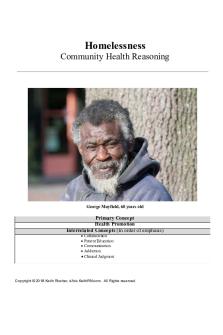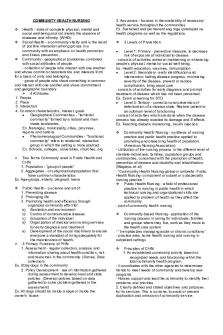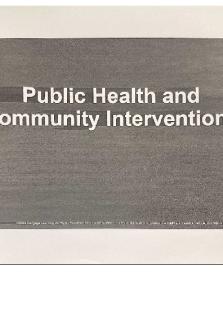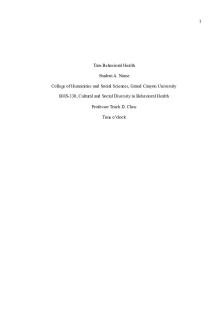Homeless Community Health Case Study PDF

| Title | Homeless Community Health Case Study |
|---|---|
| Author | Anonymous User |
| Course | Nursing Pharmacology |
| Institution | Keiser University |
| Pages | 6 |
| File Size | 246.5 KB |
| File Type | |
| Total Downloads | 67 |
| Total Views | 146 |
Summary
Case Study...
Description
Homelessness Community Health Reasoning
George Mayfield, 68 years old
Primary Concept Health Promotion Interrelated Concepts (In order of emphasis) Collaboration Patient Education Communication Addiction Clinical Judgment
Copyright © 2018 Keith Rischer, d/b/a KeithRN.com. All Rights reserved.
History of Present Problem: George Mayfield is a 68-year-old African American male with a past history of hypertension, but has not taken his meds the past year because it was too much bother and he felt fine. He is seen at a clinic that serves the homeless in a large metropolitan community. George came to the clinic because of a headache that has been persistent the past week and blurred vision. His clothing is dirty and he has a strong body odor as well as smelly feet. His shoes are shabby and he has lots of callouses on his feet. George is missing many teeth and those that remain are yellow and brown with dental decay. When the nurse reviewed the health screening questions, George admitted that he has had a productive cough with occasional bloodtinged yellow mucus the past couple weeks. His initial BP is 188/96.
Personal/Social History: George is veteran who served in Vietnam. He has struggled with alcohol abuse in the past but denies ETOH use in the past year. He has been homeless since he lost his job as a mechanic ten years ago and currently lives in his car, a 1980 Cadillac, with Milo, his white poodle. He has never married and has no close friends or relatives with whom he stays in contact. He smokes one pack of cigarettes a day. What data from the histories are RELEVANT and must be interpreted as clinically significant by the nurse? RELEVANT Data from Present Problem: Clinical Significance: 1. Past history of HTN, not taken his meds because it was too much bother and he felt fine. BP: 188/96 2. Persistent headache and blurred vision 3. Dirty clothes and strong body odor, smelly and callouses of his feet. Missing many teeth, remaining are yellow/brown with dental decay 4.RELEVANT Productive cough with occasional Data from Social History: blood-tinged yellow mucus 1. Struggled with alcohol abuse and smokes one pack of cigarettes a day 2. Homeless since he lost his job about 10 years ago and lives in his car with his dog 3. No close friends or relatives
1. His BP is elevated due to not being compliant with his medications 2. This may be due to his high blood pressure 3. The client is not able to provide proper hygiene care because he lives in his car, he smokes a pack of cigarettes a day and struggled with alcohol abuse 4. The client may be presenting an infection
Clinical Significance: 1. These play a role with his blood pressure and how his teeth are looking 2. He is not able to provide proper hygiene care and this is evident with his dirty clothes, smelly body odor, and smelly feet. 3. The client does not have any kind of support, this may affect the way he takes care of himself
Patient Care Begins: Current VS: T: 97.6 F/36.4 C (oral) P: 90 (regular) R: 18 (regular) BP: 182/90 O2 sat: 90% room air
P-Q-R-S-T Pain Assessment: Provoking/Palliative: Nothing/nothing Dull ache Quality: head Region/Radiation: 7/10 Severity: continuous Timing:
What VS data are RELEVANT and must be interpreted as clinically significant by the nurse? RELEVANT VS Data: Clinical Significance: 1. BP: 182/90 2. O2 sat: 90% room air 3. Continuous headache with rating pain 7/10
1. The client was not compliant with his medication 2. The client smokes a pack of cigarettes daily 3. May be due to his high blood pressure
Copyright © 2018 Keith Rischer, d/b/a KeithRN.com. All Rights reserved.
Current Objective Assessment: GENERAL Clothing soiled, hair and beard unkept. Has foul body odor, shabby shoes and smelly feet with callouses. Teeth are yellow stained and many are missing with obvious poor dentition APPEARANCE: Breath sounds clear bilaterally upon inspiration, coarse rhonchi heard in bases bilaterally RESP: upon expiration, occasional harsh productive cough with blood-tinged yellow mucus Pink, warm & dry, no edema, heart sounds regular with no abnormal beats, pulses strong, CARDIAC: equal with palpation at radial/pedal/post-tibial landmarks NEURO: Alert & oriented to person, place, time, and situation (x4) Abdomen flat, soft/nontender, bowel sounds audible per auscultation in all four quadrants GI: GU: Voiding without difficulty, urine clear/yellow Voids three times during the night SKIN: Dirt on hands and under fingernails, fungal toenails present on both feet, feet persistently itch, are swollen, macerated and moist with peeling of the skin layers between toes on both feet.
Current Subjective Assessment: SUICIDAL RISK:
SLEEP ASSESSMENT:
NUTRITIONAL ASSESSMENT:
-The patient does not state any kind of suicidal though upon assessment, but he may be at risk due to the way he is living now combined with his painful continuous headache -Due to living in his car, the client may not be sleeping properly because he may be checking around at night to keep himself and personal belongings safe
ETOH ABUSE:
- Assessing his nutritional status is important because he is living in his car with his dog and is not working at the moment. He may not be able to eat something every single day - The patient denies EOTH abuse for the past year
DEPRESSION ASSESSMENT:
-Assessing for depression is important with this client because of his living conditions
What assessment data is RELEVANT and must be interpreted as clinically significant by the nurse? RELEVANT Assessment Data: Clinical Significance: 1. General appearance:dirty clothes, hair and beard unkept. Foul body smell, teeth are yellow stained and many are missing 2. Resp: Coarse rhonchi heard in bases bilaterally upon expiration, occasional harsh productive cough with blood tinged yellow mucus 3. Skin: dirt on hands and under fingernails, fungal toenails present on both feet, feet persistently itch, are swollen, macerated and moist with peeling of the skin layers between toes on both feet.
RELEVANT SUBJECTIVE Assessment Data: 1. Suicidal 2. Nutritional 3. Depression
1. The client does not have the means to be able to provide self care, yellow tinged and missing teeth may be due to lack of oral care and continuous smoking 2. The client may be experiencing an infection 3. The client is not able to provide proper hygiene care
Clinical Significance: 1. To see how the client is feeling about his current situation 2. This is necessary to see if the patient is getting adequate nutrition, with his situation may not be getting enough nutrients because he does not have a job therefor he may not be eating every day 3. The client may be at risk for depression because he may not be able to pay for his care
Copyright © 2018 Keith Rischer, d/b/a KeithRN.com. All Rights reserved.
1.
List the physical and psychosocial problems that are adversely impacting his health? What are the physiological OR psychosocial causes of the problem? Physical Problem(s) Cause and/or Pathophysiology 1. High Blood Pressure 2. Yellow tinged and missing teeth 3. Itchy feet
1. Due to not taking his BP medication 2. He smokes a pack of cigarette daily and does not provide proper oral care 3. May be due to a fungal infection
Psychosocial Problem(s)
Cause and/or Pathophysiology
1. Homeless, lives in his car 2. No job
1. Not being able to provide proper self care 2. He may not be able to buy food therefore proper nutrition will be lacking
2. Is there a RELATIONSHIP between his social history and physical/psychosocial problems that may have contributed to the development of another problem?
Physical Problem(s) 1. High BP
Psychosocial Problem(s) 1. Homeless
What then Developed? 1. Due to not having a job, he was not able to buy his meds plus maybe the stress of not having a job he took buying his meds as not being necessary
What then Developed? 1. When he lost his job about 10 years ago
2. What are the priority physical/psychosocial problems and resultant assessments? PRIORITY Problems: PRIORITY Nursing Assessments: 1. Self-care 2. Control his BP 3. Productive cough
1. Assessing the whole body and document about it. Provide oral and body care if possible 2. Ask about the past medications that he was taking 3. Ask about when exactly did the cough started
Copyright © 2018 Keith Rischer, d/b/a KeithRN.com. All Rights reserved.
What are the nursing interventions at the primary, secondary and tertiary level of care? (Nursing roles to consider are the following: educate, advocate, manage, collaborate, leadership)
Primary Prevention Level: Keep disease or injury from occurring. (Educate) 1. We can educate the patient about the importance of taking his meds to prevent any type of complications 2. We can educate the client about community resources where he may go to may be take a shower, provide oral care, and get a meal
Secondary Prevention Level: Detect and treat existing disease or injuries. (Screen and treat) 1. If meds are giving, teaching the patient how to take them to treat the high blood pressure 2. If the client goes to the community sources, tell him the importance of self care
Tertiary Prevention Level: Reduce the disease or injury to lowest level to minimize disability. (Rehabilitation). 1. Make sure that the client is taking his meds and following the proper hygiene
High Incidence Problems in Homeless Population: Start by considering all the information you have regarding this client who is homeless. What are the problems most frequently seen in a homeless population? 1. Hygiene problems 2. Medical problems, because they are not able to pay for medications or may not be compliant with them
Copyright © 2018 Keith Rischer, d/b/a KeithRN.com. All Rights reserved.
Practice Settings/Community Resources: Pick the practice settings that might offer resources to the patient. Describe the resources offered and/or the nursing role for the selected settings. Only choose the relevant practice settings.
Practice Setting Public Health
Community Resources 1. May be able to offer medical attention
Role of Nurse 1. To work within the community to support population health and deliver preventive health care services
Forensic
1. Works with crime victims to gather medical evidence and provide expert testimony that can be used in court
Clinic
1. Aid patients from the moment they enter the clinic by collecting patient information
School
1. Supports student success by providing health care through assessment, intervention, and follow-up for all children within the school
Occupational
1. This may be helpful to educate the client on smoking cessation
Faith-Based
1. Developing disease prevention programs, such as smoking cessation, exercise, and healthy eating programs 1. Is a multifaceted wholistic practice focused on individuals, families, and the faith and broader communities
Home Health/hospice
1. Hands-on nursing care around the clock in the patient's home or a hospice
Senior Center
1. They counsel and advise those dealing with lifestyle changes or health concerns, and can refer seniors for physician care 1. Provide primary care, health education and disease prevention; they act as social workers, therapists, and advocates
Homeless shelter
1. They may offer shelter and food
Transcultural: Describe how the cultural factors relate to the care of this patient in the categories listed below. Race/Ethnicity: 1. The client may believe in certain things and we need to make sure we know them to be able to work around in what he believes in
Environmental Health
Vulnerable Population:
1. The client may be used to be living in a certain way, so changing up his environment may cause him some distress
1. He is a vulnerable population because he does not have an "adequate" shelter where he knows that he will be okay and he does not have a job, that can cause him to not eat every day
Copyright © 2018 Keith Rischer, d/b/a KeithRN.com. All Rights reserved....
Similar Free PDFs

ATI Community Health Study
- 22 Pages

CAFS Study Notes Homeless
- 10 Pages

Community health final
- 14 Pages

Community Health Nursing RLE
- 15 Pages

Community Health Diagnosis
- 136 Pages

ATI Community Health Focus
- 24 Pages

Community Health Nursing Kaplan
- 41 Pages
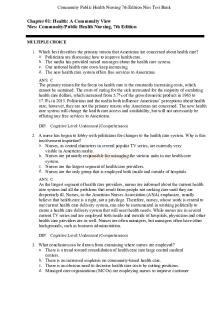
Community Health Test Bank
- 10 Pages
Popular Institutions
- Tinajero National High School - Annex
- Politeknik Caltex Riau
- Yokohama City University
- SGT University
- University of Al-Qadisiyah
- Divine Word College of Vigan
- Techniek College Rotterdam
- Universidade de Santiago
- Universiti Teknologi MARA Cawangan Johor Kampus Pasir Gudang
- Poltekkes Kemenkes Yogyakarta
- Baguio City National High School
- Colegio san marcos
- preparatoria uno
- Centro de Bachillerato Tecnológico Industrial y de Servicios No. 107
- Dalian Maritime University
- Quang Trung Secondary School
- Colegio Tecnológico en Informática
- Corporación Regional de Educación Superior
- Grupo CEDVA
- Dar Al Uloom University
- Centro de Estudios Preuniversitarios de la Universidad Nacional de Ingeniería
- 上智大学
- Aakash International School, Nuna Majara
- San Felipe Neri Catholic School
- Kang Chiao International School - New Taipei City
- Misamis Occidental National High School
- Institución Educativa Escuela Normal Juan Ladrilleros
- Kolehiyo ng Pantukan
- Batanes State College
- Instituto Continental
- Sekolah Menengah Kejuruan Kesehatan Kaltara (Tarakan)
- Colegio de La Inmaculada Concepcion - Cebu

